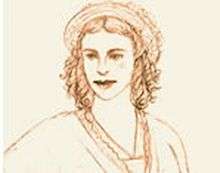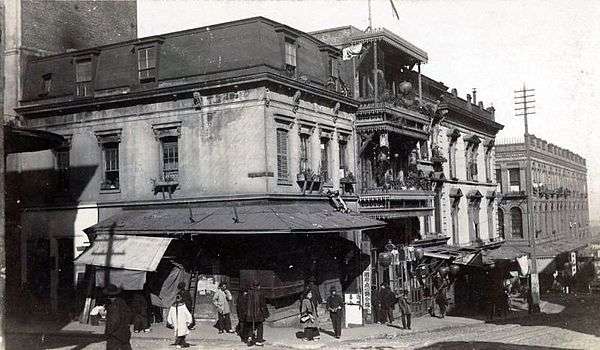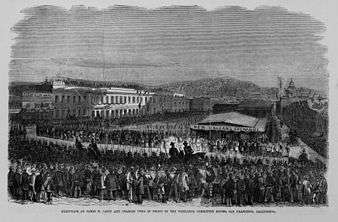Belle Cora (Arabella Ryan)
| Belle Cora | |
|---|---|
 | |
| Born |
Arabella Ryan 1827 Baltimore |
| Died | 1862 |
| Occupation | Madam |
Belle Cora (1827? –1862), also known as Arabella Ryan, was a successful Madam of the Barbary Coast during the mid-nineteenth century.[1][2][3] She rose to public attention in 1855 when her lover, Charles Cora, killed US Marshall William H. Richardson. The fight between Charles and Richardson started at the American Theatre.[4] Richardson's wife complained that Belle Cora, a well-known parlor house owner, and Charles Cora, a frequent gambler[5] were seated in the same balcony as her.[6][7] She stated that they should be in the general admission pit seats rather than the more expensive areas reserved for more respectable guests.[8] As a result, Richardson went to ask the manager of the theatre to remove the couple, but the manager refused saying that they were regular customers of the first balcony.[8] Richardson left swearing vengeance upon Charles Cora, and two days later the confrontation led to his death.[8]
Life
Two portrayals of Belle Cora's childhood exist.[4] The first lists her as the daughter of a minister in Baltimore.[4] In this version, Cora becomes pregnant as a teen.[4] When her father finds out, he throws Cora out of the house, prompting her to move to New Orleans.[4] It is then supposed that the baby died and she met Charles Cora.[4] The alternate and more prominently upheld version depicts Belle Cora to be the daughter of Irish Catholic parents in Baltimore.[4] In this version, she and her sister work at a dress shop next to a brothel.[9] Intrigued by the house, they become involved with the sex trade.[9] It is then supposed that Belle Cora ventured to Charleston, South Carolina.[4] During her time there, she became the mistress of a man who was later killed.[4] The death prompted her to move to New Orleans[10]
Charles Cora
In New Orleans in 1849 she met Charles Cora.[4][11] In December 1849, the couple moved to Sacramento, California.[4] While there, Belle helps fund Charles Cora's high stakes gambling.[4] After some time, the couple moved to Marysville, California where Belle Cora opened her first brothel.[4] It was called the New World[12][13] gambling parlor and offered games like Poker, Roulette, Faro and Dice.[1] At 23, Belle Cora moved yet again and opened another brothel in Sonora, California.[4]

In 1852, Belle set up her infamous parlor house on Washington street in San Francisco opposite the house of Ah Toy.[4] Reverend William Taylor recounts the parlor house as being furnished with redwood, velvet, silk, demask, beautiful paintings and playing pianforte, harp and melodeon.[14] Belle Cora hosted dinner parties with the mayor, Aldermen, judges and even members of the legislature.[4] After an immense legal battle and the lynching of her husband, Belle Cora continued to run her brothel.[4]
Belle was 29 when Cora was hung and died at 35 in 1862, of pneumonia, she was buried in the Calvary Cemetery next to her husband. In 1916, the San Francisco Bulletin published a serial on Belle Cora by Pauline Jacobson, and as a result, Belle was disinterred from Calvary Cemetery and reburied with Cora beneath a common headstone at the Mission Dolores Cemetery.[15][16][17][4][18][6]
The Murder
The conflict first started after Belle Cora held a competing party (which had more guests) the same night as Mrs. Richardson.[1][19] The feud was further provoked after Belle and Charles Cora were in the same balcony seats as Mr. Richardson and his wife at the American Theatre.[8] A few days later, General Richardson was murdered in front of Fox and O'Connor's store on Clay street between Leidesdorff and Montgomery Street.[20] On November 17, 1855 between 6 and 7 o'clock, Charles Cora shot General Richardson in the breast causing almost instantaneous death.[21][20][15]
Timeline
- 1855 November 17 : between 6 and 7 o'clock, Charles Cora shot General Richardson
- 1856 January 17 : Trial of Charles Cora ends with hung jury. Rumors that jurors were bribed. A new trial to begin.[22]
- 1856 May 15 : The 2nd Committee of Vigilance is formed.
- 1856 May 17 : The Committee gains 2500 members, collects guns, and conducts "army" drills
- 1856 May 18 : 3,000 armed members of the Committee of Vigilance take Charles Cora and James P. Casey[23]
- 1856 May 18 : In Sacramento, Governor Johnson, in response,[26]
- appoints William Tecumseh Sherman as the Major-General commanding
- the San Francisco division of the California State Militia.
- 1856 May 20 : The 2nd Committee of Vigilance trial[27]
- 1856 May 22 : The Committee of Vigilance hang Charles Cora and James P. Casey,[28]
- at their headquarters at 41 Sacramento St. in front of a crowd of 20,000
Arrest
Charles Cora was arrested and handed over to the City Marshall and later placed in County Jail.[20] Immense protest and lynch mobs erupted after the murder so Mayor James Van Ness placed Charles under a higher security accommodation for his own safety.[29] Local San Francisco citizens fundraised a monument for Richardson in the Lone Mountain Cemetery and $15,000 for the eldest children of Richardson.[20][26]
Trial

Samuel Brannan delivered a speech on justice and the enforcement of the law before the trial.[29] The actual trial took place on May 20 of 1856.[27][20] Belle Cora funded several attorneys to represent Charles Cora including Edward Dickinson Baker and James A. McDougall.[30] Belle Cora paid Edward Dickinson Baker $15,000 of his $30,000 retainer in gold and sent meals to Charles Cora while he was in jail.[4] In addition, she even went so far as trying to bribe the star witness Maria Knight to change her testimony.[31] The case was framed as one of self-defense case in which Richardson was alleged to have threatened Charles Cora with a knife.[15] However, the jury could not come to a decision which led to a second trial.[15] However, James Casey murdered the prominent newspaper editor[32] James King of William sparking[33] the Vigilance Committee to resurge and seize both Casey and Cora.[30][34][35] The committee sentence both of them to hang on Friday, May 23, at 12 o'clock.[20] For fear of escape, Charles Cora was led by 3,000 men and two field pieces.[20] Before the execution, Belle and Charles got married by Father Michael Acoltti. Charles said nothing as the noose was placed around his head.[15] The cord was cut at twenty minutes past one o'clock leaving Cora to drop 6 feet and hang for fifty five minutes before being turned over to the coroner.[36][37][38][28]
Political Significance
Belle Cora's stirring up of social norms[18][10][19] is alluded to in Karen Joy Fowler's novel Sister Noon.[39] During a shift towards "civilizing" society, Belle remained steadfast in maintaining her lucrative business which was seen as immoral.[31] In the book Arresting Dress the author Clare Sears opines that Cora inspires female financial agency and the use of sex for empowerment.[8] In addition, she was an advocate fighting against gender stereotypes as exampled by her legal battle with the Vigilance Committee; ultimately she set the precedent to resist further legislation like that of 20th century Sodomy laws.[8]
See also
References
- 1 2 3 "The Story of Belle Cora", The Belle Cora restaurant, accessed February 3, 2017
- ↑ "Belle Ryan, Marysville Madame and Business Woman".
- ↑ Levy, JoAnn (17 July 2013). "They Saw the Elephant: Women in the California Gold Rush". University of Oklahoma Press – via Google Books.
- 1 2 3 4 5 6 7 8 9 10 11 12 13 14 15 16 17 18 19 Jensen, Vickie. Women Criminals: An Encyclopedia of People and Issues. ABC-CLIO, 2012.
- ↑ "Cheating, violence in the cards at Gold Rush's gambling dens".
- 1 2 Gentry, Curt (1 January 1964). "The Madams of San Francisco: An Irreverent History of the City by the Golden Gate". Doubleday – via Google Books.
- ↑ Hurtado, Albert L. (1 January 1999). "Intimate Frontiers: Sex, Gender, and Culture in Old California". UNM Press – via Google Books.
- 1 2 3 4 5 6 "Arresting Dress". Duke University Press. Retrieved February 2, 2017.
- 1 2 "For Whom the Belle Toils". FoundSF. Retrieved February 3, 2017.
- 1 2 Sophie Breider "The Best Bad Things": An Analytical History of the Madams of Gold Rush San Francisco Claremont McKenna College 2017
- ↑ "Gambling in the Old West - HistoryNet". 12 June 2006.
- ↑ Lunsford, Sarah. "Take a chance on a longshot".
- ↑ "The Life and Hard Times of Belle Ryan". 23 July 2012.
- ↑ Taylor, William. California life illustrated, 1858.
- 1 2 3 4 5 Duke, Thomas Samuel. Celebrated Criminal Cases of America. James H. Barry Company, 1910.
- ↑ "A short history of bordellos in San Francisco, part 2".
- ↑ "Charles Cora (Unknown-1856)". findagrave.com.
- 1 2 Hannah Herbert “Some Honest Women:” Gender and Morality in Gold Rush San Francisco
- 1 2 Harriet Ritvo Vision and Revision: Nineteenth-Century Women The Threepenny Review, No. 3 (Autumn, 1980), pp. 11-12
- 1 2 3 4 5 6 7 "Eyewitness: San Francisco Committee of Vigilance". 1856. Retrieved February 26, 2017.
- ↑ "Stanford University School of Medicine and the Predecessor Schools: An Historical Perspective: Part II: E.S. Cooper in San Francisco. Chapter 11. The Vigilance Committee of 1856 - Medical History Center". lane.stanford.edu.
- ↑ Gold Rush Chronology 1855 - 1856
- ↑ https://noehill.com/sf/landmarks/cal0192.asp
- ↑ http://www.sfsdhistory.com/research/chronological-list-of-sf-county-jail-locations
- ↑ http://www.sfsdhistory.com/eras/county-jail-no.-1-1915-to-1961
- 1 2 CALIFORNIA IN TIME: The Fight over Slavery through the Civil War parks.ca.gov
- 1 2 "Assassination of James King of William Surrender of Jas. P. Casey and Charles Cora to the vigilance committee, on Sunday, May 18th, 1856 / / Huestis".
- 1 2 "Execution of James P. Casey and Charles Cora, by the vigilance committee, of San Francisco, on Thursday, May 22d, 1856, from the windows of their rooms in Sacramento Street, between Front and Davis Streets / Huestis".
- 1 2 Woolley, Lell Hawley. California, 1849-1913: Or, The Rambling Sketches and Experiences of Sixty-Four Years’ Residence in That State. De Witt & Snelling, 1913.
- 1 2 Farr, James. “Not Exactly a Hero: James Alexander McDougall in the United States Senate.” California History 65, no. 2 (1986): 104–13. doi:10.2307/25158368.
- 1 2 Levy, JoAnn. They Saw the Elephant: Women in the California Gold Rush. University of Oklahoma Press, 2013.
- ↑ Williamson, G. R. (15 May 2012). "Frontier Gambling". G.R. Williamson – via Google Books.
- ↑ "Demagogue editor fired up readers, revolutionaries".
- ↑ "Hanging of Cora and Casey by the San Francisco Committee of Vigilance".
- ↑ Adams, Charles F. (1 January 2018). "Murder by the Bay: Historic Homicide in and about the City of San Francisco". Quill Driver Books – via Google Books.
- ↑ "Execution of Casey and Cora - San Francisco, 1856". Archived from the original on 2012-05-10. Retrieved February 26, 2017.
- ↑ "Sex, Vigilantism, and San Francisco in 1856". Common-Place. 03 (04). 1 July 2003 – via Common-Place.
- ↑ "The Sonoma County Journal from Petaluma, California on November 24, 1855 · Page 2".
- ↑ Fowler, Karen Joy. Sister Noon. Penguin, 2002.